Plot
The story in 1997 Brooklyn, when a series of unfortunate events causes the disappearance of Steve "Steep" Gonzales' brother. Years pass and Steep is now in high school. He does fairly well, but does not have any friends in school as he spends much of his time caring for his ill mother and drawing. He keeps out of trouble and even holds down a job at a convenience store. He often entertains the idea of being truly free from the daily grind and anxiety of isolation.
However, his whole outlook on life is changed when a Traceur steals a Snapple from the store. Steep pursues the thief, but is astounded when the Traceur runs through the urban span with such speed and agility that Steep has to give up. The next day, he is confronted by Liza, an attractive girl Steep has never associated with before. She convinces him to meet her after school where she takes him to the outskirts of town. There Steep meets a group who call themselves the "GCC" or "Gravity-Challenged Crew." He is also surprised to see Deezy, the Traceur who stole the Snapple from the convenience store.
After Steep learns that the group have been watching him for some time, they attempt to recruit him and turn him into a full-fledged Traceur or as they say in North America, Free Runner. Thus begins Steep's initiation into the world of Free-Running.

Great Teacher Onizuka, officially abbreviated as GTO, is a Japanese manga series written and illustrated by Tooru Fujisawa. It was originally serialized in Weekly Shōnen Magazine from January 1997 to February 2002. The story focuses on 22-year-old ex-bōsōzoku member Eikichi Onizuka, who becomes a teacher at a private middle school, Holy Forest Academy, in Tokyo, Japan. It is a continuation of Tooru Fujisawa's earlier manga series Shonan Junai Gumi and Bad Company, both of which focus on the life of Onizuka before becoming a teacher.

Parkour is a training discipline using movement that developed from military obstacle course training. Practitioners aim to get from one point to another in a complex environment, without assistive equipment and in the fastest and most efficient way possible. Parkour includes running, freerunning, climbing, swinging, vaulting, jumping, plyometrics, rolling, quadrupedal movement (crawling) and other movements as deemed most suitable for the situation. Parkour's development from military training gives it some aspects of a non-combative martial art.

Aishiteruze Baby is a shōjo romance manga by Yoko Maki. It was serialized by Shueisha in Ribon from April 2002 and January 2005 and collected in seven bound volumes. It was adapted as a 26-episode anime television series produced by TMS Entertainment and Animax, broadcast in Japan on Animax from April to October 2004. The series is about a teenage boy, Kippei, who becomes the caretaker of his 5-year-old cousin, Yuzuyu, after her mother abandons her. Both the manga and anime have been praised for successfully mixing serious issues with a light-hearted tone.
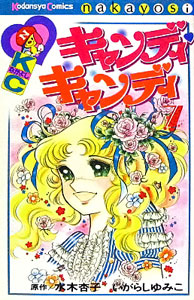
Candy Candy is a Japanese historical romance novel, manga, and a classic anime series. The main character, Candice "Candy" White Adley is a blonde girl with freckles, large emerald green eyes and long hair, worn in pigtails with bows. Candy Candy first appeared in a prose novel by famed Japanese writer Keiko Nagita under the pen name Kyoko Mizuki in April 1975. When Mizuki joined forces with manga artist Yumiko Igarashi, the Japanese magazine Nakayoshi became interested in Candy Candy. The series was serialized as a manga series in the magazine for four years and won the 1st Kodansha Manga Award for shōjo in 1977. The story was adapted into an anime series by Toei Animation. There are also four animated short films.
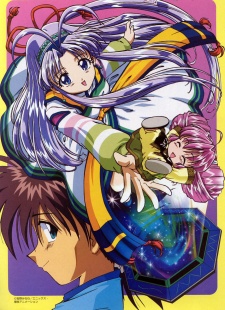
Mamotte Shugogetten is a manga by Minene Sakurano which was serialized in the monthly magazine Shōnen GanGan from 1997 to 2000. A continuation was published in Comic Blade titled Mamotte Shugogetten! Retrouvailles from 2002 to 2005. The manga was adapted into a 22-episode anime television series produced by Toei Animation which aired from 1998 throughout 1999. An eight-episode OVA series, Denshin Mamotte Shugogetten was released in 2000.

Honey and Clover is a Japanese manga series written and illustrated by Chica Umino. It is also known as HachiKuro (ハチクロ) and H&C. It is published by Shueisha, initially serialized from June 2000 to July 2006 in the magazines CUTiEcomic, Young YOU, and Chorus, and collected in ten bound volumes. The series depicts the lives and relationships of a group of art school students who live in the same apartment building. In 2003, the manga won the 27th Kodansha Manga Award for shōjo.

Chobits is a Japanese manga created by the Japanese manga collective Clamp. It was published by Kodansha in Weekly Young Magazine from the 43rd issue for 2000 to the 48th issue for 2002 and collected in eight bound volumes. Chobits was adapted as a 26-episode-long anime television series broadcast on TBS and Animax from April to September 2002. In addition, it has spawned two video games as well as various merchandise such as figurines, collectable cards, calendars, and artbooks.

Antique Bakery is a manga by Fumi Yoshinaga depicting the lives of four men who work in a small bakery. It was published in Japan by Shinshokan and in English by Digital Manga Publishing. The series won the 2002 Kodansha Manga Award for shōjo manga. The manga was adapted as a Japanese TV drama, with the title Antique or Antique Cake Store, that was broadcast on Fuji TV in 2001, an anime television series, airing on July 3, 2008 on Noitamina, and a Korean live-action movie.

Princess Princess is the title of a fictional series written and illustrated by Japanese author Mikiyo Tsuda about the lives of three high school boys and the school they attend. The series is contained within multiple media pieces which began as a manga first serialized in the manga magazine Wings starting in 2002. After the first manga series ended, a sequel entitled Princess Princess + started serialization in the same magazine in May 2006, and finished in January 2007. An anime has since been adapted from the manga and began airing in Japan on April 5, 2006, produced by the Japanese animation studio, Studio Deen. A live action adaptation called Princess Princess D aired in Japan from June 28, 2006 to September 13, 2006. Finally, a visual novel video game for the PlayStation 2 based on the series was released on October 26, 2006 in Japan.

We Were There is a Japanese romance manga by Yuki Obata, which chronicles the relationship between Motoharu Yano and Nanami Takahashi, starting from their teenage years and continuing during their early twenties. It has been serialized in Betsucomi from 2002 to 2012. The series went on hiatus in early 2008, but resumed publication in June 2009. It is licensed for an English language release in North America by Viz Media. It was adapted into a 26-episode anime television series which aired from July 3 to December 25, 2006. A 2-part live action film adaptation was released in Japanese cinemas in 17 March 2012(Part 1) and 21 April 2012(Part 2), starring Toma Ikuta and Yuriko Yoshitaka.
Ikebukuro West Gate Park (池袋ウエストゲートパーク), usually referred to by its initials IWGP, is a series of urban mystery novels by Ira Ishida. It was adapted into a very successful TV series directed by Tsutsumi Yukihiko, and then a manga, released by Digital Manga Publishing in English. An anime television series adaptation by Doga Kobo is set to premiere in 2020.

Toradora! (とらドラ!) is a Japanese light novel series by Yuyuko Takemiya, with illustrations by Yasu. The series includes ten novels released between March 10, 2006 and March 10, 2009, published by ASCII Media Works under their Dengeki Bunko imprint. Three volumes of a spin-off light novel series were also created, aptly titled Toradora Spin-off!. A manga adaptation by Zekkyō started serialization in the September 2007 issue of the shōnen manga magazine Dengeki Comic Gao!, published by MediaWorks. The manga ended serialization in Dengeki Comic Gao! with the March 2008 issue, but continued serialization in ASCII Media Works' manga magazine Dengeki Daioh with the May 2008 issue.
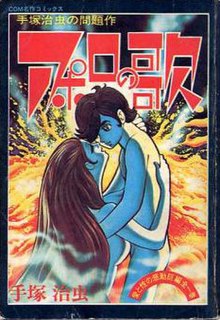
Apollo's Song is a manga written and illustrated by Osamu Tezuka. It was originally serialized in Weekly Shōnen King in Japan in 1970 and was published in English translation in 2007.
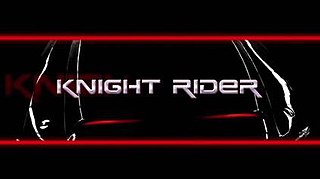
Knight Rider is a 2008 American made-for-television action film which was created to serve as a backdoor pilot for the new Knight Rider television series, a revival of the 1982–1986 series of the same name. This film does not refer to either the Knight Rider 2000 film or the Team Knight Rider television series.

Otomen is a Japanese romantic comedy manga written and illustrated by Aya Kanno, which began in Bessatsu Hana to Yume in late 2006 and concluded on November 26, 2012. The series has been adapted into a live action TV drama. The series has been one of the best-selling shōjo properties in America, since being licensed by Viz Media. The series is also licensed in France by Delcourt and in Spain by Planeta DeAgostini.

Kimi ni Todoke: From Me to You is a Japanese shōjo romance manga by Karuho Shiina. It was published by Shueisha in Bessatsu Margaret from 2005 to 2017 and collected in 30 tankōbon volumes. In 2008, it won the Best Shōjo Manga award in the 32nd Annual Kodansha Manga Award. The series was also nominated for the first Manga Taisho awards in 2008. Two anime adaptations of Kimi ni Todoke were aired in Japan, produced by Production I.G. The second season of the anime was announced in Betsuma Magazine, began airing in Japan on January 4, 2011 and lasted for 12 episodes. A live action film adaptation was released in 2010 starring Mikako Tabe and Haruma Miura.

The Moon and the Sandals is a Japanese manga series written and illustrated by Fumi Yoshinaga, her debut work. Originally serialized in Hanaoto magazine, the individual chapters were collected and published in two tankōbon volumes by Houbunsha in March 1996 and February 2000, respectively. It follows the romantic relationships of high school teacher Ida, his lover, a student named Kobayashi who develops a crush on Ida and is rejected, and the fellow student whom Kobayashi comes to love afterwards.

Convenience Store Boy Friends is a Japanese multimedia project developed by Kadokawa's B's Log Comic magazine with collaboration by Lawson. The project started in 2015 and has already released mooks and bundles with drama CDs. It centers around a group of male high school students who always stop at a convenience store on their way home from school. An anime adaptation by Studio Pierrot aired from July 6 to September 28, 2017 on TBS.
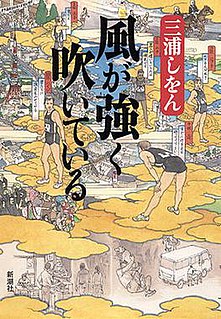
Run with the Wind is a Japanese novel by Shion Miura. The novel has received a manga and a live-action film adaptation, as well as an anime television series adaptation by Production I.G that aired from October 2, 2018 to March 26, 2019.





















